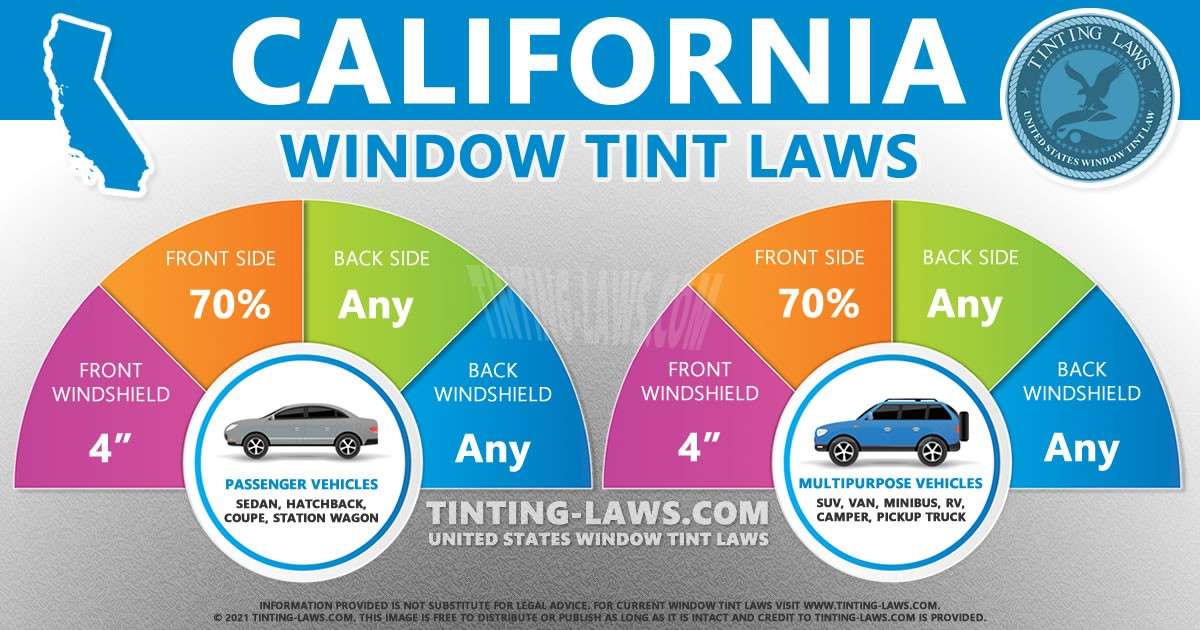California Window Tinting Laws
California window tint law restricts windshield tint on top 4 inches.
Front side windows must have 70% light transmission or more. Back side windows and rear window may have any tint darkness.
Car window tinting laws in California were enacted in 1999.
We have provided all the necessary information about your car’s window tint, including how dark or reflective the tint is allowed in your state.
There are also additional car window tinting rules and regulations in California so make sure you read all about it below.
Window Tint Darkness in California
The percent of visible light allowed through your car windows is called VLT: Visible Light Transmission.
The percentage of light allowed through your film and glass in California is very specific and different for sedan cars and SUV cars or vans.
Tint darkness for sedans:
- Windshield: Non-reflective tint is allowed on the top 4 inches of the windshield.
- Front Side windows: Aftermarket film must allow more than 88% of light in, or minimum 70% VLT if combined with factory-tinted windows.
- Back Side windows: Any darkness can be used.
- Rear Window: Any darkness can be used.
Tint darkness for SUV and vans:
- Windshield: Non-reflective tint is allowed on the top 4 inches of the windshield.
- Front Side windows: Aftermarket film must allow more than 88% of light in, or minimum 70% VLT if combined with factory-tinted windows.
- Back Side windows: Any darkness can be used.
- Rear Window: Any darkness can be used.
Window tint reflection in California
Window tint can reflect incoming light and reduce glare and heat.
California window tint law permits a certain window reflection when using a tint so make sure you pay attention to this as well.
Tint reflection for sedans:
- Front Side windows: Must not be more reflective than a standard window.
- Back Side windows: Must not be more reflective than a standard window.
Tint reflection for SUV and vans:
- Front Side windows: Must not be more reflective than a standard window.
- Back Side windows: Must not be more reflective than a standard window.
Other California window tint rules and regulations
California does have several other important laws, rules and regulations pertaining to window tinting. They include the following:
- Side Mirrors: Dual side mirrors are required if the rear window is tinted.
- Restricted Colors: California tint laws do not permit using red, amber or blue tint colors. Side windows must be colorless.
- Certificates: Manufacturers of film must certify the film they sell in the state and the driver is required to have the certificate in their possession.
- Stickers: State law does require a certificate or a sticker from the installing company and the manufacturer’s name and address.
- Medical Exceptions: California law allows medical exemptions for lower tint on all windows.
Keep in mind that California tinting laws and regulations may be interpreted differently in your county or place of residence.
We always recommend double-checking our information with your local DMV or law enforcement authorities.

Our information about window tint laws in California was last updated in 2024.
Tinting laws in California were enacted in 1999.
In case any of our info provided is not up to date or correct be sure to contact us so we can fix it. Thanks!
State of California Info
California is a state located on the West Coast of the United States.
It is the most populous U.S. state, home to 1 out of 8 Americans, and is the third largest state by area (after Alaska and Texas).

It is home to the nation’s second and fifth largest census statistical areas (Greater Los Angeles area and San Francisco Bay Area, respectively).
As well as eight of the nation’s 50 most populated cities (Los Angeles, San Diego, San Jose, San Francisco, Fresno, Sacramento, Long Beach, and Oakland). The capital city is Sacramento.
Capital: Sacramento
Population: 39,237,836
Area: 163,696 sq mi (423,970 km2)
Cities in California: Los Angeles, San Francisco, San Diego, Sacramento, San Jose, Oakland, Santa Barbara, Mountain View, Pasadena, Anaheim, Beverly Hills, Berkeley, Monterey, Long Beach, Palm Springs, Santa Monica, Hollister, Malibu, Fresno, Bakersfield, Palo Alto, Big Sur, Calabasas, Irvine, Newport Beach, Cupertino, Huntington Beach, Napa, Temecula, Modesto, Torrance, Santa Cruz, Laguna Beach, San Luis Obispo, Riverside, Sunnyvale, Stockton, Pleasanton, Ontario, Ventura, Fremont, Menlo Park, Orange, Carmel-by-the-Sea, Carlsbad, Burbank, Santa Rosa, Solvang, Eureka
Counties in California: Alameda, Alpine, Amador, Butte, Calaveras, Colusa, Contra Costa, Del Norte, El Dorado, Fresno, Glenn, Humboldt, Imperial, Inyo, Kern, Kings, Lake, Lassen, Los Angeles, Madera, Marin, Mariposa, Mendocino, Merced, Modoc, Mono, Monterey, Napa, Nevada, Orange, Placer, Plumas, Riverside, Sacramento, San Benito, San Bernardino, San Diego, San Francisco, San Joaquin, San Luis Obispo, San Mateo, Santa Barbara, Santa Clara, Santa Cruz, Shasta, Sierra, Siskiyou, Solano, Sonoma, Stanislaus, Sutter, Tehama, Trinity, Tulare, Tuolumne, Ventura, Yolo, Yuba
Tint Law References:
Medical Exemption Info:
Assembly Bill no. 1303 (September 2017) – amended medical exemptions